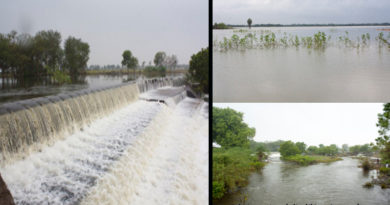Stylish killers. The fashion industry as the second largest planet polluter
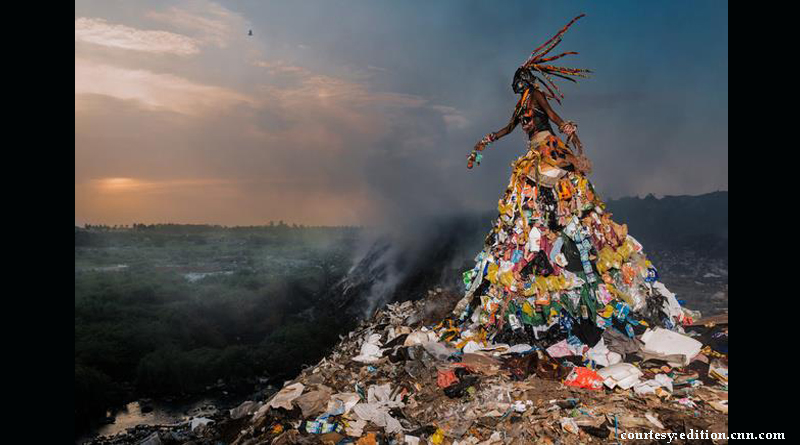
The Fashion industry has never been bigger. Or, as it turns out, more wasteful than it is right now. With increasing incomes, fashion has also come into its own, evolving from being just clothes in large parts of the world to being a part of ones identity. Today, it is one of the most common tools used to carve out a distinct social and political identity . The Aam Aadmi party Cap, the ,the congress kurta, the TMC saree, the list is really endless. This has been enabled by an industry that can produce much faster, at ‘lower’ costs. Which is where the good story ends.
Fashion today is the second largest polluter in the world after the oil and gas industry. With over 80 billion garments produced each year and a 400% increase in the amount of clothes purchased from 20 years ago. What is the true cost of fashion?
According to MarketLine, a business information company global apparel sales have been growing at the rate of 4.78% a year since 2011, valued at $1.4 trillion USD in 2017, the market shows a potential increase of 5.91% for the next two years. As per the report sales should reach a staggering $1.65 trillion USD in 2020 which is a 60% increase from 2011. The reason for this growth spurt is due to the rising GDP levels which enable people to spend more money on items of luxury rather than necessity.
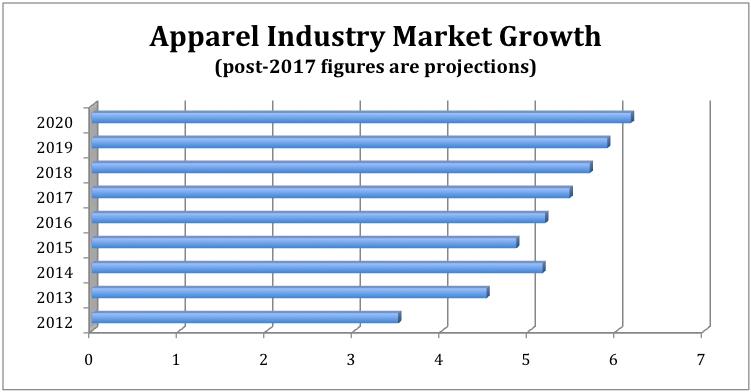
Lets follow the trail of the most bought and worn item of the fast-fashion industry, the T-shirt. Every year more than 2 billion T-shirts are sold worldwide. Most T-shirts are made of a blend of polyester, nylon and cotton.
Polyester overtook cotton as the most used fabric in the textile industry in the early onset of the 21st Century. It is a petroleum by-product. The production of polyester results in the emissions of heavy metals, greenhouse gases and nitrous oxide. Most polyesters use antimony as catalysts, which are carcinogenic in nature. Nylon, like polyester is also a petroleum by-product, releasing tonnes of toxic gases in its making. Both the materials needless to say are non-biodegradable. In 2015, polyester released more than 706 billion kgs of CO2 emissions globally. To put it in smaller terms a single polyester T-shirt produces 5.5kgs of CO2. In addition to the global emissions, washing of polyester and nylon clothes release half a million metric tons of microfibers annually. These tiny particles of fibres add to the plastic levels in our oceans and pose a threat to marine life.
Cotton is a thirsty crop whose production has great repercussions on land as well as water. 2.5% of the world’s arable land is dedicated to grow cotton. Cotton consumes approximately 198 trillion litres of water annually and 11% of the pesticides used globally.
Let’s look at the production of this crop on a domestic scale. India is the largest cotton producing country (27 million 480 lb. bales, 2017) and the second largest cotton exporting country in the world (4.6 million 480 lb. bales, 2017). The cotton industry in India employs about 40-50 million people. However, India is one of the most inefficient agriculture producers in the world, growing water intensive crops in water scarce regions (you can read more about this topic by clicking here). Cotton utilizes 6% of the total irrigation water in India and consumes 44.5% of the total pesticides used in the country. The rise in use of pesticides is causing major health problems among the cotton farmers. A documentary called “ the true cost” showcases how children of Indian cotton farmers are being born with serious birth defects. Even though worldwide cotton is being modified against bollworm (Bt cotton) so as to reduce the consumption of pesticides, in India due to the lack of knowledge these crops are not being grown properly. The very pests the crops are meant to repel inevitably affect them, hence failing in their purpose to reduce the usage of pesticides. One might bring up the notion of organic cotton, which is currently promoted by high-street brands like Zara but this tiny fraction of agriculture just makes up 1% of the global cotton produced.
Once the raw materials are sourced to the factories the next phase of pollution begins. The fashion industry is the second largest user of water globally according to the United Nations Economic Commission of Europe (UNECE). One cotton T-shirt requires 2700 litres of water in its production, that’s the amount of water consumed by a person in 2.5 years. The production of clothes utilizes various dyes and pigments, these add alarming amounts of lead, mercury, arsenic and many other chemicals in water, making fashion and in particular textile dyeing the second largest polluter of clean water globally; contributing 17-20% of the total fresh water pollution. Many T-shirts or pieces of clothing also contain nonylphenol a toxic substance that affects the hormonal systems of aquatic life forms; this substance is released once the piece of clothing is washed.
Most of the clothes produced in the world are from low-income countries. This is mainly due to the availability of cheap labour. China, India, Bangladesh, Vietnam and Turkey are just a few countries that fast-fashion brands outsource their production to. Once the clothes are produced they are shipped all around the world to their respective stores. The fashion industry as a result accounts for 10% of the global emissions.
But fashion’s trail of pollution doesn’t end here; it extends way after one discards their clothes.
Clothes are hard to recycle due to the limited options available to recover the non-biodegradable fibres present in them. With almost 60% of the clothes being disposed in a year of their production, only 1% are recycled within the clothing industry and 13% are recycled in other areas. A lot of these discarded items add to the millions of garments that make up our landfills. The UNCE reports that 85% textiles ultimately end up in landfills or are incinerated.
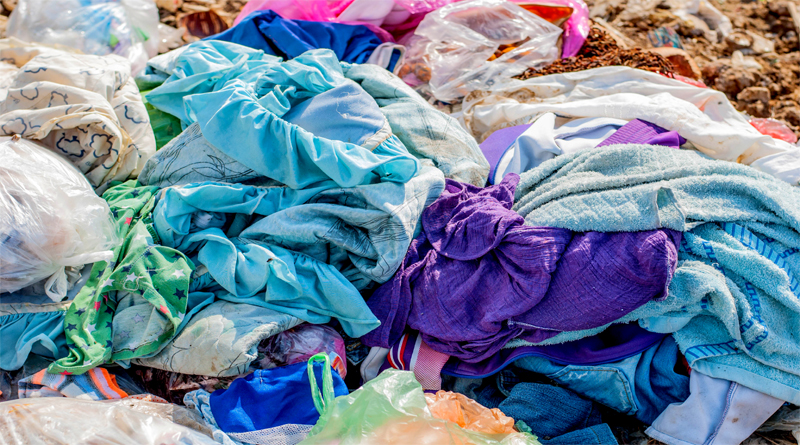
Even though a lot may donate their old clothes, it is important to note that the fast paced fashion industry produces mostly low quality clothes; hence most of our donations ultimately get burnt or end up in landfills. Having said that, it is always better to donate and up-cycle clothes rather than throwing them away as not only would it extend the cloths life cycle by a few years but donating would also help a person in need.
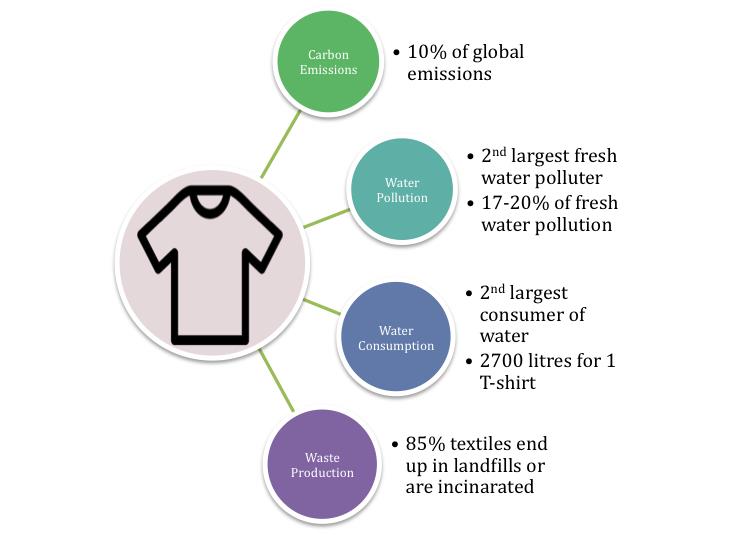
The only way out of the vicious world of fast-fashion is to promote quality over quantity. Educating the community about sustainable fashion and in a way making people conscious of their choices is important, as the consumer drives the market. Promoting local textile industries is another way to reduce global emissions as shipment would be done locally and a lot of the clothes are made using traditional looms, which have less of an impact on the environment. Besides, it will boom the local economy.
So next time you walk through a mall or surf through your favorite online clothing store and decide to help yourself to some retail therapy, ask yourself do you really need it or do you just want it?
![]()

